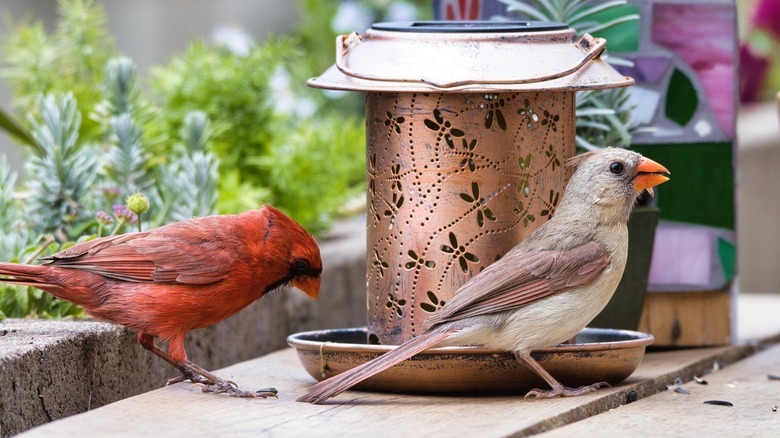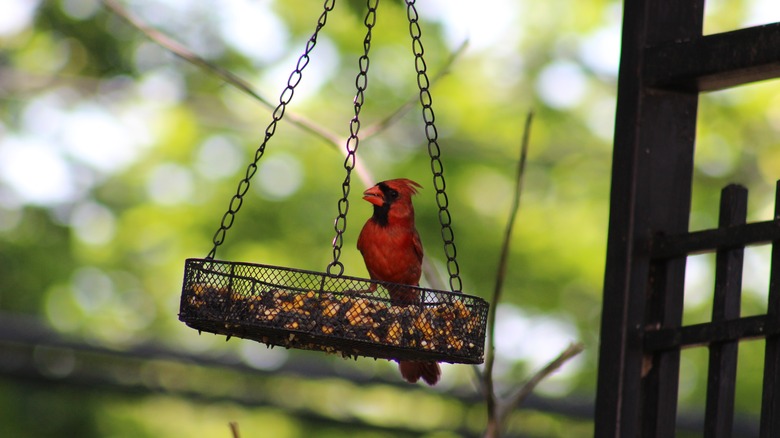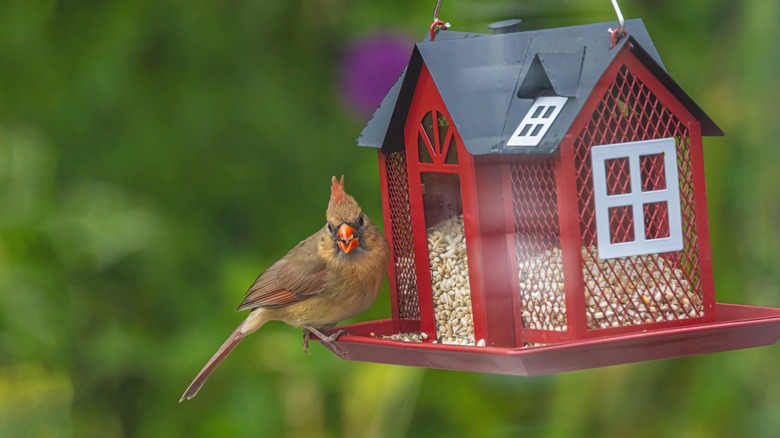What It Means If You Hear A Cardinal Calling Out From Your Bird Feeder
Hearing birdsong by your feeder is a special treat, especially when it brings warmth to your yard during chilly winter months. Many keen-eared birdwatchers wonder, however, if they can decode the cardinal's message — and if there is a message for them to hear at all. After all, understanding what a songbird wants and providing it seems like a clever way to attract more cardinals to your yard.
Stephanie Beilke, Senior Manager of Conservation Science at Audubon Great Lakes, explains in an exclusive interview with House Digest that the answer is complex. "We're not aware of any scientific evidence suggesting that cardinals call out to prompt humans to refill feeders," she said. Like all birds, continued Beilke, cardinals sing to fulfill a variety of their needs. Feeders can serve as a meeting spot for birds, where they are likely to interact both socially and aggressively.
While it's hard to discern why a bird is calling without directly observing its behavior, it can be a good sign for your efforts. "If they associate a certain location with reliable food," Beilke explained, "they might vocalize nearby to signal their presence, especially if they've learned that food often appears in a certain area after specific human activity." The more frequently you hear birdsong near your feeder, the more likely this is to be true.
Do cardinals remember specific bird feeders?
If you have a keen eye, you may think you notice the same bird or groups of birds flocking to your feeder. To what extent do cardinals form attachments to specific bird feeders? To answer this — in her exclusive chat with House Digest — Beilke first shared how a cardinal's memory works.
"Cardinals and many other bird species are known to have spatial memory, allowing them to recall food sources and return to familiar locations for sustenance," she explains. "Cardinals will often remember reliable food sources, such as feeders, and can develop regular feeding routines around them. Like other birds, cardinals exhibit behaviors where young birds observe and learn from adults."
As you care for and stock your feeder, your local birds — including cardinals — will take note. This can have an especially profound effect on young birds, who are still learning how to forage. "While [birds] may not 'teach' in the same way humans do, juvenile cardinals are likely to follow and mimic adult behaviors, including visiting feeders," adds Beilke. What starts as following adult birds can lead to teaching juvenile cardinals to remember your feeder as a reliable source of food. They'll not only be more likely to visit, but they may even pass this knowledge down to the next generation of cardinals by example.
What to do if you hear a cardinal in your yard
Suppose you recognize a cardinal's call near your feeder. It may not be communicating directly to you, but can you learn anything about their needs as they talk to each other? The last thing a birdwatcher wants is to make a mistake when trying to attract cardinals, scaring off the wildlife. In her exclusive interview with House Digest, Beilke first recommends enjoying the birdsong, even if you don't know what the cardinals are communicating to each other. She also notes that there are plenty of steps you can take to make your yard a comfortable space for cardinals. While these birds may not tell you directly what they want, you can fill your feeder with the best seeds for cardinals, like sunflower, white milo, and safflower seeds.
Beilke also suggests referring to her Audubon Bird Guide to learn the variety of calls a cardinal can make and what they tend to mean. "Their song is often described as a series of melodious whistles and chirps, including a clear, high-pitched 'cheer-cheer-cheer' or 'birdie-birdie-birdie,'" she said, "and this is used primarily for attracting mates and defending territories."
Additionally, you can make sure to position your feeder in a safe spot. She shares the following advice to protect your feathered friend: "Minimize the risk of window collisions by placing bird feeders less than 3 feet or greater than 10 feet from your home, installing exterior window screens to make reflective glass more visible to birds, and turning off excess lighting at night, especially during spring and fall migration."


